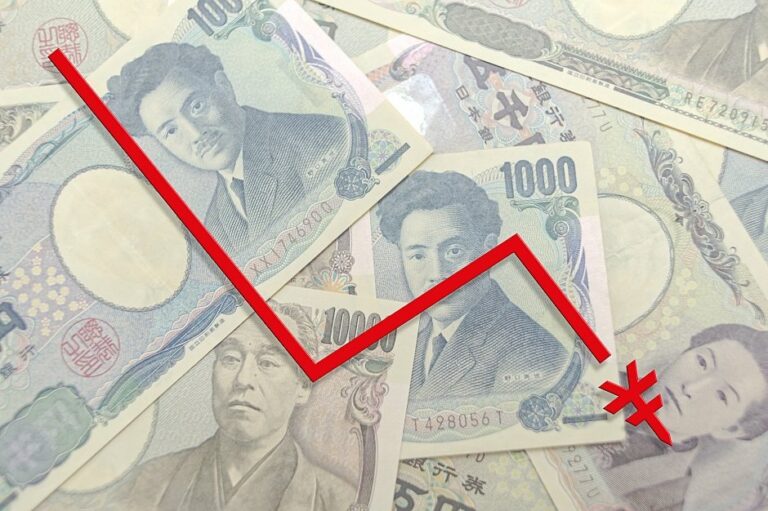In September 2022, Japanese yen exchange rate temporarily fell to 144 yen level against the US dollar on the Tokyo foreign exchange market. It was the first time for past 24 years that the yen has depreciated. The concern and anxiety about the rapid depreciation of the yen against the dollar is beyond description. Why is Japanese yen weakening so much? What is the cause? What is the strategy background by Bank of Japan and the prospect? I will explain it in an easy-to-understand manner.
Why is Japanese yen weakening?
Background of the depreciated yen is difference of interest rate between Japan and US/Europe. Central banks in Europe and the United States are rushing to tighten monetary policy in order to stop record-breaking inflation. On the other hand, Bank of Japan continues to implement large-scale monetary easing. In short, the direction of monetary policy is different.
Long-term interest rates in the United States were hovering around 1.5% until the end of 2021. However, in February 2022, FED (Federal Reserve Board): the central banking system of the United States, did strengthen monetary tightening and raised to 2% level as concerns about inflation increase due to soaring raw material prices following Russia’s invasion of Ukraine. After that, against the backdrop of the view that FED accelerated monetary tightening to deal with record-breaking inflation, long-term interest rates continued to be raised further, rising to the 3% level in May 2022.
On the other hand, long-term interest rates in Japan have been kept to around 0% (with upper limit of around 0.25%) as part of large-scale monetary easing by Bank of Japan. At the beginning of the year, difference of the interest rate between Japan and the United States was about 1%. But now, it became to about 3%. Therefore, it leads to [buy US dollar/sell yen], and cause depreciation of Japanese yen.
Differences between US/European and Japanese policies
Regarding future policies, the difference between Europe, the US and Japan is becoming clearer. FED in the US raised the policy interest rate in March 2022 and lifted the zero interest rate. In May 2022, they decided to raise the interest rate by 0.5%, and they plan further interest rate hikes in the future. Bank of England was expected to raise interest rates again in June, and the European Central Bank (ECB) also decided to raise interest rates by 0.5% in July 2022. Then in Sep 2022, FCB raised it by 0.75%. On the other hand, Bank of Japan has firmly maintained the policy of continuing current large-scale monetary easing.
Policy Background of Bank of Japan
Mr. Kuroda, who is Governor of Bank of Japan, said, “Japan’s economy and prices are very different from those countries in Europe and the US, so there is absolutely no situation to tighten monetary policy.”
Japan has not recovered to the GDP level before the spread of COVID-19
The scale of “GDP = Gross Domestic Product” was 541 trillion Japanese yen on an annual basis from October to December 2019, while it was 538 trillion yen from January to March in 2022. This means that Japan has not recovered to the level before the spread of COVID-19.
Tightening now could hurt the economy ?
Wages per worker in April 2022 increased by only 1.7% compared to the same month of the previous year. Although the increase reflects the recovery of the economy, the increase is still moderate. For this reason, if monetary easing turns to tightening in the current phase, there is a risk that the economy will cool down through rising interest rates and other factors. Bank of Japan will continue to tenaciously monetary easing in order to create a positive cycle in which both wages and prices rise.
What is their view on the current weakening yen?
They all know that the rapid depreciation of Japanese yen is negative and undesirable for the economy since it increases uncertainty about the future and makes it difficult for companies to formulate business plans. If the difference of interest rates widen further, Japanese yen might be weaking further and it may have a greater negative impact on the economy while the US accelerates the monetary tightening. At this stage, Bank of Japan is faced with a difficult situation in which either maintaining monetary easing or tightening monetary policy could worsen the economy.
What will happen next?
The current trend of yen depreciation will not be reversed soon, and inflation in Japan may accelerate further due to increased costs for energy, food, and logistics. The reason for the depreciation of the yen is not only the difference in interest rates between Japan and the US, but also the reality about impression for Japan: the growth potential is weak. It is important to show how Japan is revitalizing in economic strength, increasing competitiveness in the international business, and how to take action. Monetary policies in other countries have not succeeded yet. We all are still in the process of exploring which way is good.
Summary
- The reason why Japanese yen is weakening is that there is a gap about the interest rate between the policies of the US/EU and Japan. Therefore, Japanese yen has tendency to be sold instead of buying dollar.
- As of Sep 2022, Japanese economy hasn’t recovered completely yet.
- What happens next is unclear. They need realistic and practical policies.
Recently, people are worried about the sharp depreciation of Japanese yen for the first time in 24 years. Let’s see how the situation will work well. Hope Japan will head in a good direction.



コメント